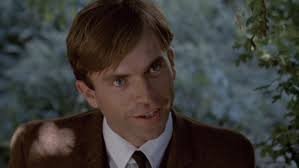- All This and Heaven, Too (Anton Litvak)
- Joy (David O. Russell)
- The Wedding March (Erich Von Stroheim)
- Manhatta (Charles Sheeler/Paul Strand)
- Grass (Merian C. Cooper/Ernest B. Schoedsack)
- Shadow of a Doubt (Alfred Hitchcock)
- Chang (Merian C. Cooper/Ernest B. Schoedsack)
- 3:10 To Yuma (Delmer Daves)
- The Golem (Carl Boese/Paul Wegener)
- My Brilliant Career (Gillian Armstrong)
.
1- All This and Heaven, Too is the perfect example of what was known as a ‘woman’s picture’. Nothing pejorative meant by that. It was a particular genre that was extraordinarily popular at the time. Star-crossed romances, attractive tragic protagonists, luscious scores by Max Steiner. I guess things like the Twilight series are the diminished descendents of these films. Since this starred the great Bette Davis, I was expecting a plot with a little more meat and a tougher heroine. Still, it was fun enough. I don’t get why Charles Boyer was such a sex symbol, but he was. Must have been the French accent.
2- I think that David O. Russell makes movies just for me. I absorb them effortlessly and with great satisfaction. The quirkiness of the plots and characters is never condescending. His stable of actors is immensely appealing. Silver Lining Playbook and American Hustle were absolute delights. Joy is also a joy. He might be becoming formulaic, but it is such a tasty formula!
3- Each time I watch a Von Stroheim film, I am amazed that he succeeded in getting it made. The elaborateness of the productions, the penetrating psychology of the characters, the epic scope make you wonder how the studio heads ever agreed to his projects, especially since they were hugely expensive and perhaps not box-office smashes. I hadn’t seen The Wedding March in a long, long time, but it really holds up as an exemplar of what makes a Von Stroheim film so masterful. It is tragic that the second part of the film, The Honeymoon, was lost in a fire in Paris in the Fifties, but there are enough stills and information for us to piece together what the end of this melancholy story would have looked like. The recent discovery of the complete Metropolis makes me take heart that The Honeymoon might be found in some European basement someday. It is not like the missing reels of Greed which were deliberately destroyed by the studio, apparently. This just seems to be a case of neglect. Keeping my fingers crossed. Take a look at my survey of Von Stroheim if you have not already.
4- Bless TCM for their monthly perspectives. This month, they are focusing on documentaries. This gave me the chance to see three short films that I had always heard about but never had the opportunity to see. Manhatta is an astounding 11-minute silent film showing views of New York from highly artistic and interesting camera set-ups. Grass and Chang are the products of Merian C. Cooper & Ernest B. Schoedsack, the boys who brought us King Kong. Granted, these are not documentaries in the strictest sense as many of the sequences seem staged, but just to imagine the difficulty that this kind of location filming presented in the 1920s makes these films even more amazing. Someone described Chang, set in the jungles of Thailand, as a ‘wild animal snuff film’. Cute, and somewhat accurate. But the anthropological details of the life of these people is so interesting. Grass is absolutely thrilling. It depicts the epic journey of the Bakhtiari people from central Turkey to somewhere in present-day Iran. They are fleeing the dried out fields of Anatolia for the lush grassland of Iran to feed their flocks. Grass equals life here. I was dazzled by the camera work and could not imagine how these epic set-ups were co-ordinated. CGI has truly killed the thrill of this kind of cinema!
5- 3:10 To Yuma should be as regarded and as well known as High Noon. When westerns are great, they are sublime, like The Searchers and Once Upon A Time In The West. When they are very good, they are very, very good, like 3:10 To Yuma. I am talking about the original here, with Glenn Ford and Van Heflin. Don’t know anything about the remake. Like most remakes, I question the wisdom of the whole enterprise. (Probably only John Huston’s version of The Maltese Falcon was the only necessary and transcendent remake!). When critics talk about the greatness of later westerns, they usually focus on the psychological depictions of the characters. Here, the cat-and-mouse between Ford and Heflin keeps the whole thing taut and involving. And that last shot in the rain is gorgeous.
6- I was glad finally to catch up with The Golem. It was one of the major German Expressionist films that I had not seen. I watched it since it was one of the films covered in the new podcast The Chosen Films created by two friends of mine, Aaron Midler and Rabbi Shoshana Conover. They discuss films from a Jewish perspective and their selections are eclectic. I don’t think this film is as majestic as others of this time (The Cabinet of Dr. Calegari, Metropolis or Faust, but it is fascinating for the weird but not demonizing portrayal of those medieval Jews. See it.
7- The late 70s/early 80s were a heady time for ‘art house’ cinema. Bergman, Fellini and Hitchcock were still active, and we were discovering new corners of the cinematic universe. Most impressive was what was called The Australian New Wave. Fascinating, accomplished films like Picnic At Hanging Rock, The Last Wave and Gallipoli burst Athena-like, fully-formed and glorious. My Brilliant Career was a film that I saw at the time and liked a lot, but had completely forgotten about. I was glad to catch up with it again and see that it was even more satisfying than I remembered. And Sam Neill is gorgeous.

